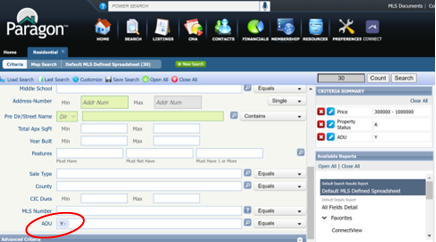What it’s like to live on the Grand Mesa in Colorado
I have visited the Grand Mesa multiple times, hopefully you have too. Have you ever wondered what it’s like to live on the Grand Mesa? Is there fast internet? How much snow do they really get? What’s there to do up there year-round?
I post short videos and announce new website posts on my Facebook page called Live Your Vacation in Grand Junction.
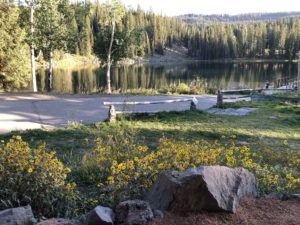
Grand Mesa in September near Mesa Lakes Lodge
Let’s start with some Grand Mesa quick facts
Colorado’s Grand Mesa is the world’s largest flat-top mountain with over 300 lakes in about 500 square miles. Most of “the Mesa” is about 10,000 ft above sea level. Powderhorn Mountain Resort offers over 1,600 acres of year-round diverse terrain for all levels of abilities. There are lush forests of aspen and evergreen trees and beautiful wildflowers. There are numerous resorts offering tons of activities for every season.
Sounds great, right? But what’s it like to live on the Grand Mesa? Here’s some extra information about the area and some FAQs answered by locals to give you a feel for the area to help decide if you’d like to live on the Mesa.
Driving on the Grand Mesa
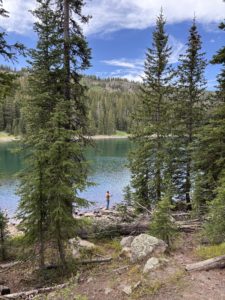
Fishing Island Lake on the Grand Mesa
There’s one main road that crosses the Mesa, Hwy 65, also known as the Grand Mesa Scenic Byway. Yes, it’s scenic! From Grand Junction, head East on I-70. Take the exit for Hwy 65 to head south. It takes about 30 minutes to get to the town of Mesa, CO and 45 minutes to get to Powderhorn. Get your Google maps set up before you leave Grand Junction because you probably won’t have cell service on the Mesa.
Continue on Hwy 65 and you’ll reach the town of Cedaredge, then Delta, and you can circle back up Hwy 50 to Grand Junction. Or…
If you want a “local experience” add a stop at the Lands End Observatory to your itinerary. After you see the spectacular overlook of the Grand Valley consider this. If your vehicle is less than 35 feet and you are not towing a trailer, head down Forest Road 100, a scenic gravel road with numerous switchbacks. Also known as Lands End Road. It will come out in Whitewater. Be aware that the narrow road is a two-way road and passing can be tight in spots. I recommend driving down, not up. Be sure you know how to downshift your vehicle so you don’t rely on your brakes the whole way down.
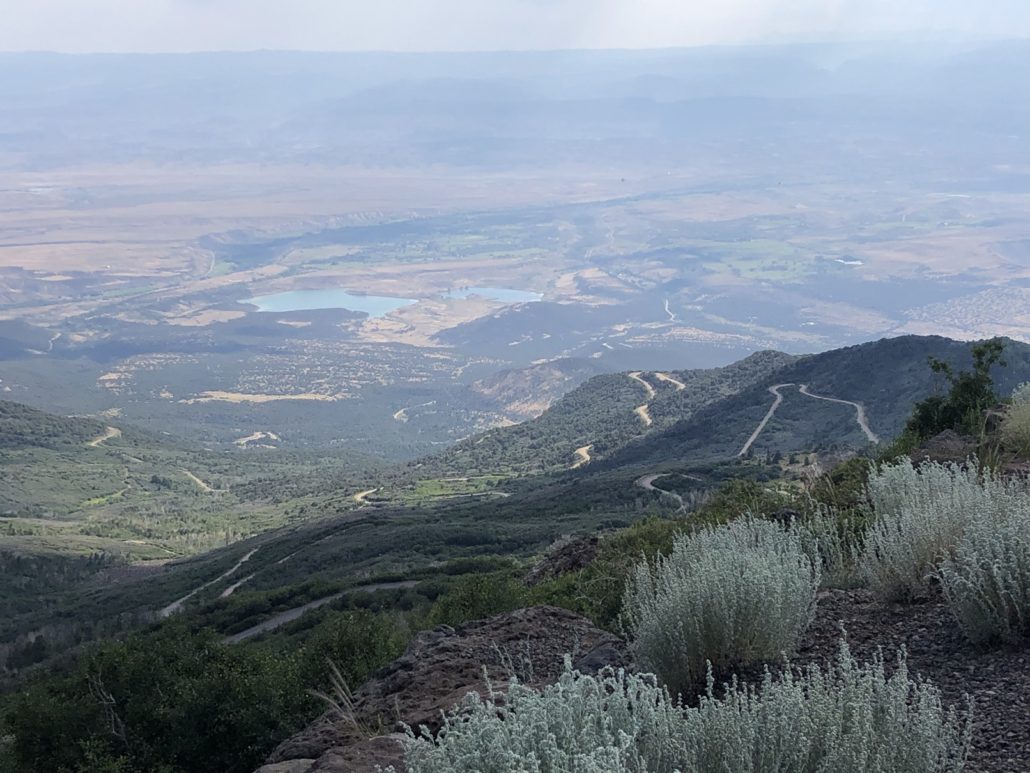
I took this picture from the top of the Grand Mesa looking down the Lands End Road into Whitewater. Oh the switchbacks!
How much snow does the Grand Mesa get annually?
Downhill skiing, Nordic (cross-country) skiing, snowshoeing, snowmobiling, ice fishing and other winter sports and recreational activities are popular on the Mesa. Powderhorn Mountain Resort reports this on their website, “The mountain annually receives over 250 inches of light powder snow across a range of groomed runs, aspen & pine glades, and volcanic boulder fields, perfect for skiers and riders of all skill levels.” The Grand Mesa Lodge explains it this way on their website, “With an average annual snowfall of 420 inches (35 feet) the Grand Mesa has epic snow for your adventures. Explore hundreds of miles of trails right from your doorstep or join us for a guided snowmobile ride.”
So, let’s just say the Mesa gets a lot of snow. As a resident, you can rely on Mesa County to plow the primary roads. If you live on the outskirts of Mesa, CO, there may be some roads that require private snow removal contracts beyond clearing snow from your driveway.
Can you get fast home Internet on the Grand Mesa?
Of course! Satellite Internet services like Starlink work great all-around remote Colorado. Some residents take their Internet with them when they road trip away from home.
Can I have a garden?
Yes! The growing season in Colorado can vary from 30 to 150 days, depending on the average last killing frost in the spring and the first killing frost in the fall. On the Mesa, the frost season ends in late April and doesn’t start again until the end of October. Because of wildlife in the area, be sure to enclose your garden with a fence 6’ or higher.
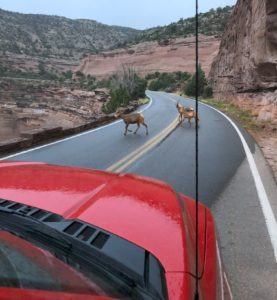
Driving down from the Mesa near I-70
How does wildlife impact living on the Grand Mesa?
You’ll want to keep your garbage in bear-proof containers. Make sure the paths around your home are well-lit at night. Keep your gutters clean. Typical home ownership responsibilities apply here too. Be cautious driving at night. And even driving during the day as you may come across big horn sheep along the side of the road, especially along the creek right as you get onto the Grand Mesa Scenic Byway from I-70.
Over 400 moose roam the Mesa along with tons of mule deer. Here’s what the VisitGrandJunction.com website has to say about the moose. “When you’re hiking through the woods on top of the world’s largest flat-top mountain, the Grand Mesa National Forest, listen carefully for snapping branches in the distance. Keep your eyes peeled for lumbering beasts moving amongst the trees. The dense pine forests and aspen groves, combined with hundreds of miles of streams and the wetlands from over 300 lakes, make this mountain an ideal home for moose.”
What about Fire Protection Services?
Your homeowner’s insurance rate will depend on how close you are to a fire department so do your research. Here’s a link about our wonderful Mesa County Fire Authority who services the Grand Mesa National Forest area. And here’s the link to the fabulous Plateau Valley Fire Department covering 700 square miles in Mesa County including the areas of Collbran, Georgia Mesa, Grove Creek, Jerry Gulch, Maigatter Knob, Mesa, Molina, Plateau City, Plateau Creek State Wildlife Area, Powderhorn & Round Mountain. If you need a reputable insurance agent that does a great job for rural homeowner’s, give me a call.
What public schools would my child attend?
Mesa County provides a detailed county public school boundary map that allows you to easily review all of the school boundaries. You can enter a specific address to determine which school children will attend. Keep in mind, boundaries are subject to change due to housing growth and population changes. The southern part of the Grand Mesa, Cedaredge for example, is in Delta County so you’ll want to check the Delta County School District website. Plus, there are alternative schools, charter schools and private schools to consider.
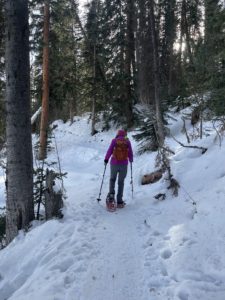
Snowshoeing on the Mesa near Mesa Lakes Lodge
What is there to do when living on the Grand Mesa?
First and foremost, the people I work with move to the Grand Mesa for the beauty, the views, the solitude and the access to outdoor activities. You will enjoy hiking, biking, downhill skiing at Powderhorn, world-class cross-country ski trails, big game hunting, snowmobiling, fishing (summer and winter) or kayaking the 300 lakes is just a start. You’ll never come up short of ideas to take it all in.
With its proximity to Grand Junction, Palisade, and Fruita you are just a short drive into the city with all the conveniences you could ever need. There are not many places in the world where you can enjoy a morning of ice fishing then take part in a round of golf in the afternoon with a short drive into the Grand Valley. Living on the Grand Mesa truly has everything you could ever dream of when considering rural living.
Read how my past clients have described the type of service I offer my clients, all of my clients, every time! Paul Aspelin Reviews and Recommendations.
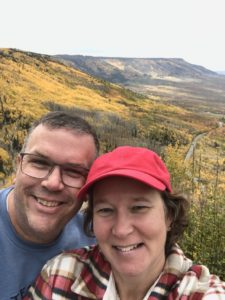
Fall on the Grand Mesa
Learn more about the area by reading my Top Day Trips from Grand Junction.
Connect with me on LinkedIn or send me an email.
Live Your Vacation in Grand Junction!
Text/Call 612-306-9558
PAUL ASPELIN, REALTOR®
GRI, SRES®, CNE
Grand Junction Real Estate Expert
Learn more about my experience and how I serve my clients
© 2024 Paul Aspelin, REALTOR®. MovetoGrandJunction.com Copyright protected. All rights reserved.

